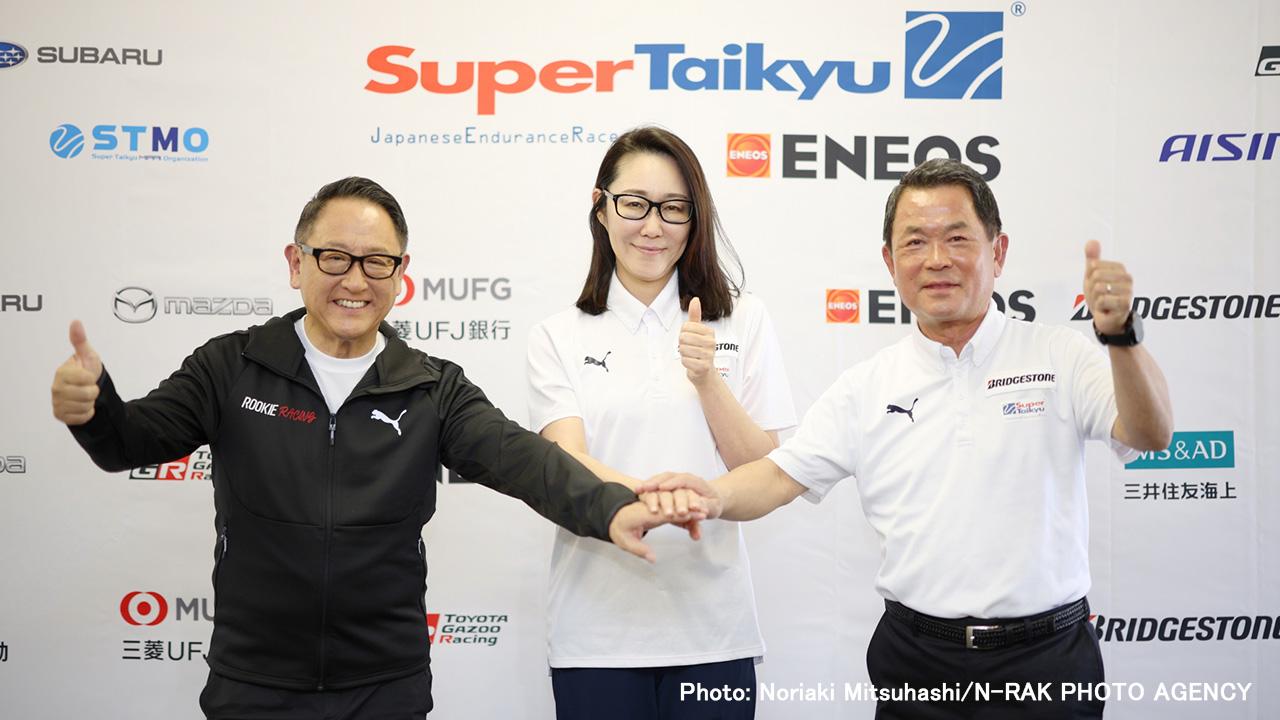
The racing series will be run by the newly launched Super Taikyu Mirai Organization, chaired by none other than Morizo, aka Akio Toyoda. What is the new body's vision for Super Taikyu's future?

On April 20, the 2024 ENEOS Super Taikyu Series Empowered by Bridgestone kicked off at Sportsland SUGO in Murata, Miyagi Prefecture.
The start of the new season was marked by an announcement of a new structure of the Super Taikyu’s organizing body.
The current Super Taikyu Organization (STO) will transfer its operations to the Super Taikyu Mirai Organization (STMO). Led by Akio Toyoda (aka Morizo) as chairpersonas vice chairperson, the new team will take over running the series from June.
Five days earlier, the STO notified the media that it would hold a press conference about the series’ new structure. The fact that Morizo was listed as a participant caused something of a stir among those involved.
So what is the STMO, and why has Morizo been picked for the top job? How will this change Super Taikyu?
We report our findings from the press conference speeches and Q&A session.
Kuwayama: “To keep it growing, pure and straightforward”
The press conference began with an address by STO CEO Kuwayama. She reflected on the 11 years she spent safeguarding the series to carry on her late husband’s legacy and explained her reasons for asking Morizo to head the new organization.
Address by STO CEO & Incoming STMO Vice Chairperson Harumi Kuwayama
The Super Taikyu Organization has decided to transfer its operations to a new body, the Super Taikyu Mirai Organization.
To explain this change, today, I am joined by Morizo, the new chairperson, and Toshiyuki Kato (former executive vice president of Denso), who will serve as managing director.
Before that, I would like to take just a brief moment to reflect on my own experience.
My husband and former STO CEO Mitsuru Kuwayama passed away on March 2, 2013. Until that point, racing had never been part of my life. Needless to say, I knew nothing about how it operated.
This happened right when entries were being finalized for the 2013 season, and despite my lack of understanding, I went on coordinating the entries.
During those hectic days, I remember thinking about carrying on my husband’s work. It felt as though something inexplicable was pushing me forward, and I decided to go for it.
I was told that I could just serve as a figurehead, and others would take care of the rest.
Yet I felt that, without a proper understanding, I couldn’t help the series to grow, so I said, “Let me start by learning how everything works.”
I remember the looks of surprise on everyone’s faces. No doubt, I made many people concerned about what lay ahead.
After a while, I realized something. I got the impression that, in the racing world, people may say many things, but rarely do they put these thoughts down on paper or turn them into action.
I wanted to become competent in practical affairs so that I could be useful. When I began attending races with that mindset, I felt that, in my own inexperienced way, I could see what needed to be done.
I arrived at the two things that I felt were crucial for Super Taikyu at the time: to straighten out the rules and to build a brand.
I feel that the past 11 years of Super Taikyu have been spent eliminating these issues, one by one.
For a long time, whenever I met with manufacturers, I encouraged them to make more use of Super Taikyu as a platform for development.
During his life, my husband also saw this as the true purpose of this racing series. I recall sharing this with Morizo when we met in Okayama.
From this perspective, I didn’t need to think twice about establishing the ST-Q class (for automobile manufacturers to field development vehicles). Back then, however, I never dreamed that it would become the place for testing the visionary technology that is the hydrogen engine.

Fortunately, I believe that Super Taikyu is now in a very good position. With the support of our teams and corporate sponsors, the series is attracting a growing fanbase even as we remain inclusive to amateur drivers.
The excitement around the ST-Q class has highlighted our role, not simply in providing fun races but also as part of the auto industry.
In thinking about the future of this series, however, we need to consider the next step. I began to wonder whether continuing to manage Super Taikyu with my own small company was the best way forward. For the past few years, I found myself constantly wrestling with this question.
Thanks to continued support, Super Taikyu has amassed more than 30 years of history. What elements must be preserved? And how can we preserve them while ensuring that the series also offers everyone involved a sense of the future?
As I struggled with this, the only person that came to mind was Morizo.
Super Taikyu is a very pure, straightforward form of racing. To keep it growing and expanding without deviating from this path, there was only one person to whom I could turn.
Though I wasn’t sure whether I could ask that of him, Morizo listened to what was on my mind. Personally, I feel that I could not turn to someone who is driven only by money or prestige.
Watching Morizo in these races made me certain that this was not the case and spurred me to reach out to him.
When I consulted him, Morizo’s first question was, “Have you discussed this with anyone else?”
Of course, I had not raised the matter with anyone else, and when I told him as much, he responded, “I’ll try to find a way to make this work for everyone.”
With that, I would like to pass the microphone over to Morizo.

